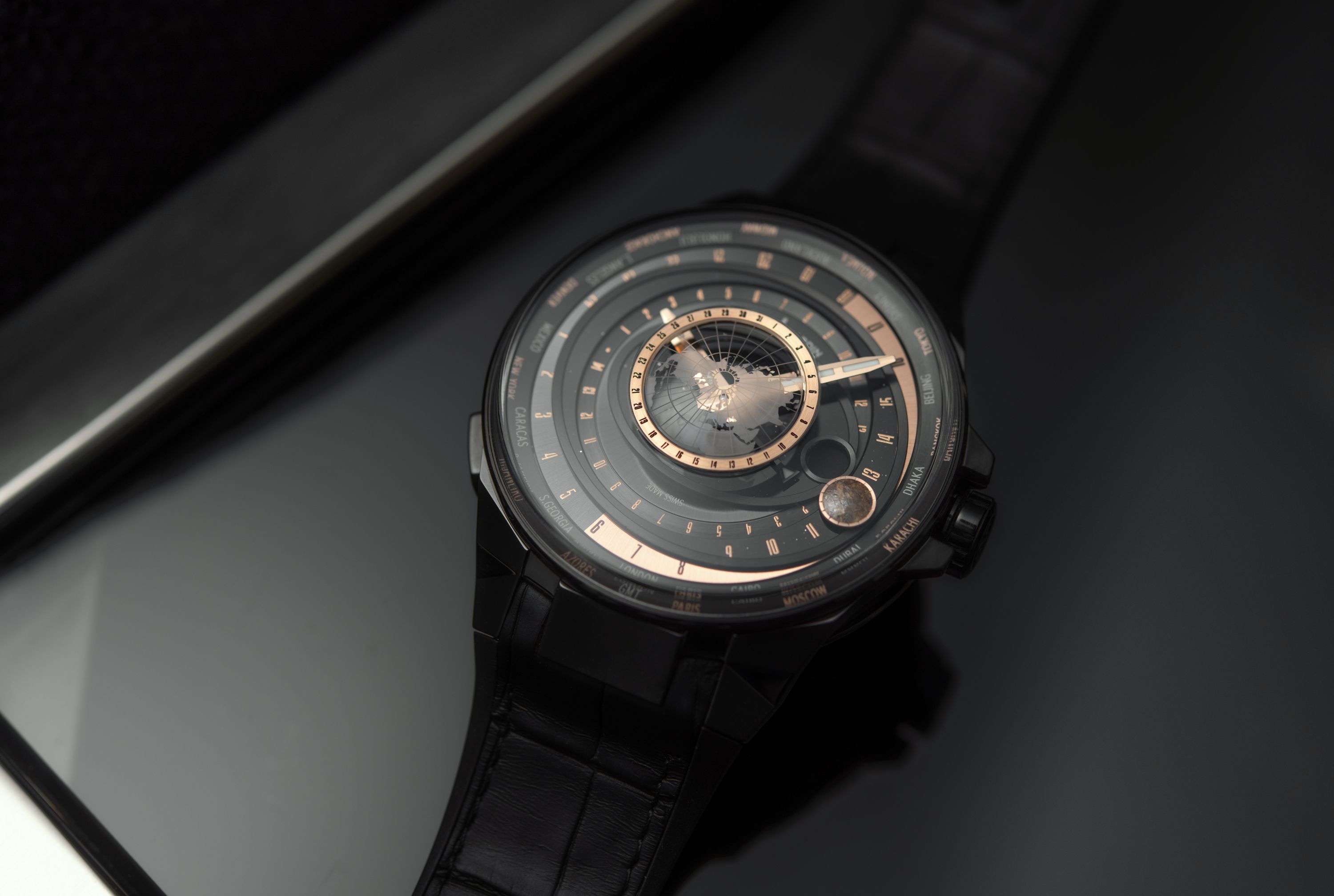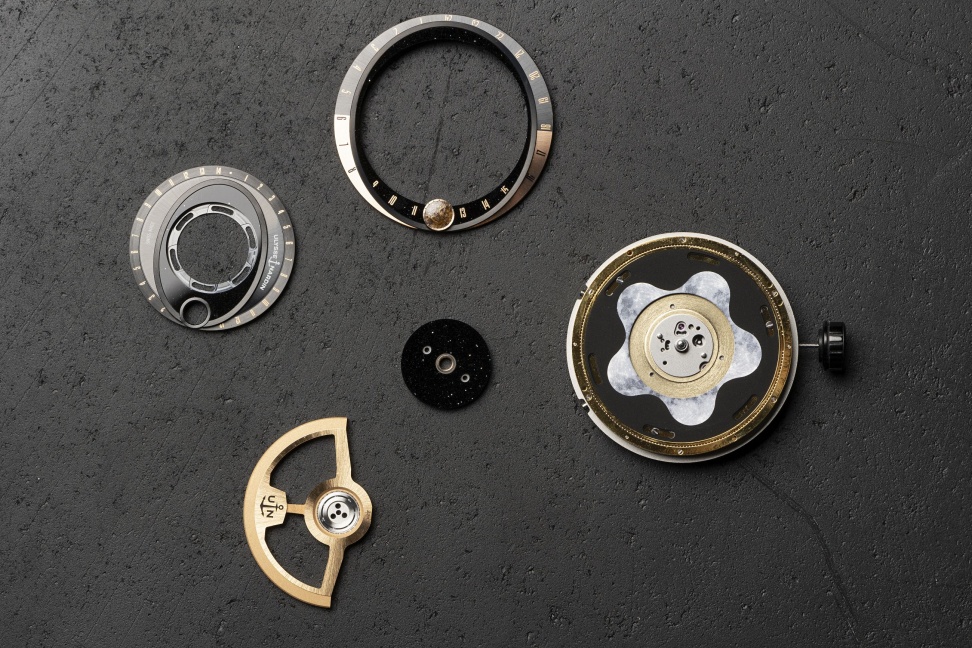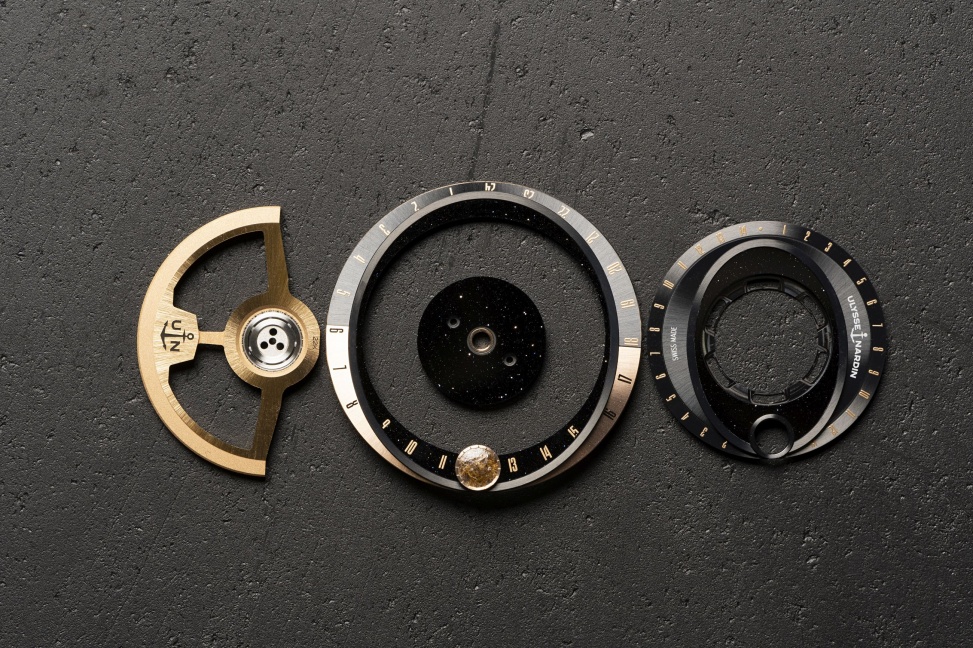Ulysse Nardin Blast Moonstruck
As a new lunar year starts today, Ulysse Nardin is launching an ultra-design version of one of its historical astronomical complications: the Moonstruck. With this Manufacture Worldtimer housed in the geometrical case of a Blast, Ulysse Nardin offers exceptional aficionados a new celestial odyssey, with reinvented watchmaking mechanics reproducing as faithfully as possible the sun’s visible trajectory and the lunar cycles. Today, this new Blast, descended from the trilogy of astronomical watches created nearly forty years ago by the master watchmaker Ludwig Oechslin, proposes to set in motion the primordial elements of the visible celestial mechanisms so that everyone can gain a poetic understanding of the universe that envelops us thanks to a contemporary and intuitive display.
I am delighted that my watches and astronomical clocks enable people to think about their position in the universe and perhaps realize that we are not the center of the world.
The Blast Moonstruck reproduces the moon’s rotation, the apparent movement of the sun around the globe as we observe it from Earth and a tidal chart. Designed to make this dance between the sun and the moon intelligible and intensely poetic, the geocentric display of the Blast Moonstruck is easy to understand, even for a beginner with no knowledge of astronomy.
Explanations
The starry firmament is a map for sailors, a playground for lovers and the primordial calendar of all civilizations. In this sparkling ballet where, as seen from the ground, Earth always appears to be at the center of the universe, the sun and moon define the cycles of the days, months and seasons. It took the genius of astronomers to decipher this waltz that keeps time so well. Ever since the Bronze Age, they have been setting up observatories that enable them to devise calendars that are accurate to the nearest day. Over the generations, they have built up their grammar of the heavens.
Why an astronomical watch? Because everything that has regular cycles can be reproduced mechanically and so be read on a dial. Encapsulating time is the watchmaker’s art. Freeing it is that of the philosopher. In a way, the Blast Moonstruck encapsulates… but above all it liberates the mind. It’s that simple.
Attractive astronomy
The Blast Moonstruck, like all watches incorporating elaborated astronomical information, seeks to be a miniaturized extrapolation of the formidable turret clocks constructed towards the end of the Middle Ages by towns of consequence. With an easily readable and understandable display, it is the successor of the astronomical instruments of the past. Thanks to its sophisticated mechanism, it assures the display of the time in a place chosen from among the 24 principal time zones that the world has been using since the Washington Convention of 1884. By means of pushers located on the left-hand side of the case, it is possible to put the main time display forward or back in leaps of one hour to adjust to another time zone.
The sun has a force that creates and destroys life. The moon influences the tides but also our nocturnal music and dreams.
The Blast Moonstruck is also fitted with a moon phase complication of precision, which, combined with the complication that allows real-time following of the sun that gives it its brilliance, adds relief and life to the dial. This scientific representation of considerable oneiric potential will serve the cause of great leaders in search of the ultimate watch, but also that of sailors, with whom the Manufacture has kept up an almost intimate relationship since its establishment in 1846. They will know the full extent of the benefits this sober and discreet display can bring them. From day to day, they will be able to predict the dates of the spring tides at a glance by observing the sun and moon aligning on their respective ellipses.
Man at the center of his universe
Designed to follow in the footsteps of the fabulous trilogy devised by Ludwig Oechslin from 1985, this watch puts aside the Copernican representation of our solar system in favor of a geocentric approach that is easier to read and understand for us others, the inhabitants of Earth.
To accentuate this sensation of being at the heart of the universe based on observation of the watch, the designers, together with the master, Ludwig Oechslin, chose to place the part of the northern hemisphere seen from the North Pole at the center of the instrument’s sapphire crystal. To increase the impact of the 3D effect, the domed crystal, with the land masses micro-engraved on the inside, is set in the protective sapphire crystal box encircled by an 18 ct rose gold ring engraved with the 31 days of the month, which has for a pointer a small triangle loaded with luminescent material.
Worldtime - Dual Time
Underneath this three-dimensional structure glide hands of the precision and contemporary design that the Blast collection is known for. Their tapering form ensures instinctive reading, even in total darkness, thanks to the presence of a generous quantity of luminescent material down the middle. They indicate the local time, set to the time of the time zone in which the watch’s owner lives. But they can also be set at will to any one of 24 time zones for which the names of corresponding cities are reproduced on the fixed flange of the dial. This can be done, forwards or backwards, by means of a sophisticated mechanism very often used by Ulysse Nardin and activated by the two rectangular pushers located on the left side of the case. Simple and intuitive, this world time function, always useful for seasoned travelers, comes together with an advanced astronomical complication.
Geocentric cosmic waltz
For Ludwig Oechslin, the 1980s designer of astronomical wristwatches among the most complex ever produced, and for the Manufacture’s development team, the Moonstruck was not intended to be an unnecessarily complicated watch, but a timepiece with a sober and efficient display, capable of rendering the celestial mechanics comprehensible to everyone.
This 45 mm diameter astronomical watch in black ceramic and black DLCtreated titanium, worn on a alligator, velvet or rubber strap that is also black, surely meets the expectations of this ambitious project.
In addition to the time display observable against a background of the night-sky portrayed by a disk made of aventurine, times around the world can be read with the aid of the fixed flange bearing the names of cities and the rotating disk on which a sun in relief and the time indications appear at 12 o’clock. The watch also has a Dual Time mechanism. This allows changing of the main display in leaps of full hours with the aid of the two pushers located on the left side of the case middle to show the time in a given country on the dial while keeping the initial time alongside the reference city. This highly efficient watch also possesses an aperture that, showing the phases of the moon in a realistic manner, associates its course with a three-dimensional representation of the sun located at 12 o’clock on the time display for the reference time zone.
Precise moon phases
The team in charge of the creation of the Moonstruck chose to provide a representation of the moon phases in a round aperture located at the apogee of an ellipse portraying its orbit, which is depicted as being in the same ecliptic plane as Earth for practical reasons. This aperture, carried by a disk, is associated with an elaborate gear train. It causes the moon phase indicator to make one complete rotation per day to follow the course of the sun, the source of the moon’s brightness, and also causes it to make a full circle of the dial in 29 days, 12 hours, 41 minutes and 9.3 seconds, representing the duration of a lunar month, also known as a synodic rotation, which has an astronomical duration of 29 days, 12 hours, 44 minutes and 2.9 seconds.
To conserve its accuracy, the aperture showing the representation of the moon retreats every 24 hours on its circle of revolution by an angle corresponding, in degrees, to 1/29.53 of a lunar month to occupy a new position in relation to the sun. At the same time, the representation contained in this small mobile aperture also evolves to appear a little brighter or dimmer in line with the lunar calendar.
When a portion of the moon is visible in it, the aperture conserves an identical position in relation to the sun, here reproduced in relief and made of bronzite, for 24 hours. This rare and precious mineral of the pyroxenes family presents a golden surface punctuated with dark patches intended to reproduce those observable with a telescope on the mantle of the star around which, in reality, the earth gravitates. The moon phase display, described as being “of precision” because it will produce a divergence of one day only after 40 years of working, is associated with markings of the ages of the moon on the ellipsis intended to represent the revolution of our natural satellite around the earth.
Appealing and original, the Blast Moonstruck remains nonetheless an instrument that materializes a certain idea of our solar system - somewhere in the vastness of the cosmos.
Complex in appearance, it is easy to read and also easy to adjust, as all the information can be set from the winding crown. A little concentration when correctly positioning all the useful information, from the reference city to the local time and date, suffices to ensure that the complication built into the automatic Manufacture caliber UN-106 subsequently manages all the displays on its own as long as the watch is worn. And when it isn’t, it just needs to be put back in the box supplied, which contains an automatic winder designed to take care of the winding and keep its calendar information accurate.
Aventurine: nothing happens by chance
If it appears that the stars are randomly distributed in the cosmos, the Blast Moonstruck’s subtle mineral black dial decoration with glittering golden particles has not been left “to chance” …
Legend surrounding aventurine recounts that in the thirteenth century, on the island of Murano in Venice, home to the famous glass-makers, a craftsman accidentally, or “par aventure”, let some copper filings fall into a pot of molten glass, so creating aventurine glass, or “avventurina” in Italian, meaning “by chance”.
The aventurine effect of this man-made mineral gives it the sparkling appearance that sailors often observe on the ocean’s surface in the darkness of night.
Ludwig Oechslin
This engineer was born in Gabicce Mare in the Italian Marches on February 10, 1952. An academic, he obtained a degree in archeology, ancient history and Greek from the University of Basel in 1976. Already working, in 1983 he was also awarded a PhD in Philosophy, History of Research and Erudition (theoretical physics) and Astronomy, this time from the University of Bern, and in 1995 a habilitation in pre-industrial technical archeology from the Swiss Federal Institute of Technology in Zürich (ETHZ). In parallel to his many studies, he undertook a watchmaking apprenticeship and became a repairer in 1984 and then a master watchmaker in 1993. Having acquired all these skills, and like the humanists of the early Renaissance, he managed to combine all these disciplines into creating watch movements which included original astronomical complications or incorporating innovative modes of operation. From 1983 to 1990, he developed for Ulysse Nardin, first, the Astrolabium Galileo Galilei watch and then two other pieces to form a Trilogy that has remained in the annals of the profession as the benchmark in terms of astronomical complications. Passionate about mechanical efficiency, this author, the winner of the Prix Gaïa in history in 1995 for his studies on monumental astronomical clocks, created the Freak watch in 2001, the very first watch in Watchmaking History to incorporate silicium into its mechanism. A lover of knowledge, he was curator of the International Museum of La Chaux-du-Fonds from 2001 to 2014.
Simultaneously, this adventurous spirit, eager to breathe life into the watchmaking principles which run through him, in 2006 created his own watchmaking brand called Ochs und Junior. Today, still bubbling with ideas, this omniscient engineer, both a researcher and a developer-designer, remains open to the elusive watchmaker whose vibrancy, he contributes, here and there, to preserving.
Technical specifications
Ulysse Nardin Blast Moonstruck
Reference: 1063-400-2A/1A
Limited production
Case
- Material: Black ceramic/Black DLC titanium
- Diameter: 45 mm
- Glass: Sapphire crystal
- Open case back, sapphire crystal & black DLC titanium
- Water-resistant to 30 meters
Dial and hands
- Black dial
- 5N red gold hands
Movement
- UN-106 Manufacture caliber
- Automatic winding movement
- Number of parts: 335
- Number of jewels: 42
- Frequency: 28,800 vph (4 Hz)
- 5N Rose gold oscillating weight
- Power reserve of 50 hours
Functions/Indications
- Hours, minutes, date
- Moon phase indication
- Days of lunar month
- Tidal coefficients
- Worldtimer
- Dual Time
- Positions of the sun and moon around the globe
Strap and buckle
- Black alligator, velvet, or rubber
- SYNC folding clasp, black DLC titanium and pink gold
MSRP
- CHF 75'000
- EUR 71'300
For more information, please visit ulysse-nardin.com
Lexicon and additonal information
Nicolaus Copernicus: This Polish astronomer, who was born in 1473 and died in 1543, revolutionized astronomy by proposing a theory of terrestrial and planetary motion in which all the planets, including ours, revolve around the sun. This heliocentric approach was rejected for a long time because it shook the medieval and religious view of the world in which God had placed Man – and consequently the earth – at the center of the universe. His system opposed the geocentric vision that held sway at the time.
The Ecliptic Plane: This is the plane that, containing the sun’s center of gravity and that of the earth revolving around it, is extrapolated to infinite to serve as the basis for a system of coordinates used in defining the positions of the stars. It is so named because it is in this plane that eclipses are observed. This plane is inclined in relation to the earth’s equatorial plane by an angle of 23° 26’ 13’’, known as the obliquity of the ecliptic. This angle corresponds to the inclination of the earth’s rotation axis in relation to the normal plane of its orbit. The moon’s orbital plane presents an average inclination of 5° 08’ 48’’ in relation to the ecliptic.
Moon Phases: These refer to the portion of the moon lit up by the sun and observed from the earth. Since our natural satellite moves in an orbit around the earth, the lunar phases evolve with the passage of the days. A lunar month corresponds to a complete cycle, the average duration of which is 29 days, 12 hours, 44 minutes and 2.9 seconds (29.53 days).
The moon rotates about its own axis at the same time as it revolves around the earth, which itself makes a complete rotation in 24 hours. And it’s precisely because the moon makes one rotation about its own axis while it makes one revolution around the earth that it ends up always showing us the same face.
New moon: When the moon is between the earth and the sun, we talk of a new moon. This configuration of the astral bodies corresponds to a high tidal coefficient (spring tide).
First quarter: When the sun and moon are in perpendicular positions on the dial (with the sun at 6 o’clock and the moon at 3 o’clock), the moon is in its waxing phase. Under these conditions, the tide has a low coefficient (neap tide).
Full Moon: When the sun and moon are face to face with the earth between them, the moon is full and the tide has a high coefficient (spring tide).
Third quarter: When the sun is perpendicular to the moon (with the sun at 6 o’clock and the moon in the left-hand sector of the dial), the moon is waning and the tide has a low coefficient (neap tide).


































Comments
Leave a comment